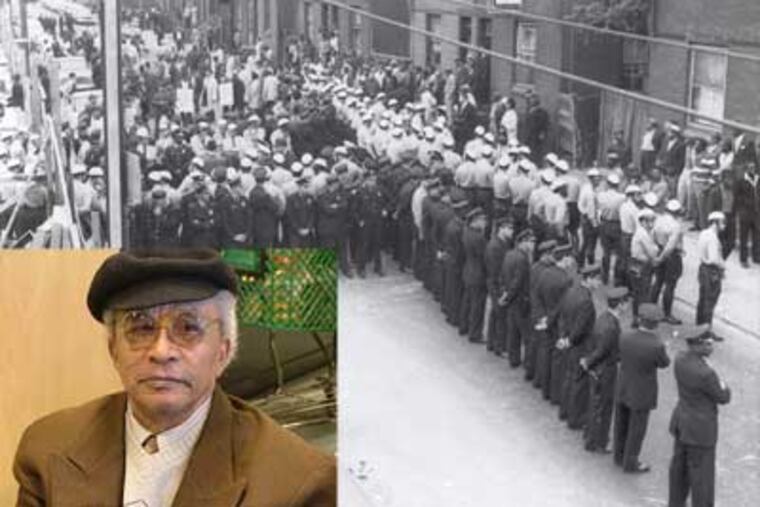Tribute to honor photographer Jack T. Franklin
In more than 400,000 photographs taken over more than 60 years, Jack T. Franklin recorded the luminaries and seminal events of the civil rights movement in Philadelphia, and by extension the African American experience during a turbulent time in the nation.

In more than 400,000 photographs taken over more than 60 years, Jack T. Franklin recorded the luminaries and seminal events of the civil rights movement in Philadelphia, and by extension the African American experience during a turbulent time in the nation.
He did so, beginning in the late 1940s, by capturing the lives of common folk, activists, and icons of the black community in a distinctive style that was meant to be viewed for generations to come.
His legacy includes photos of entertainers, from Josephine Baker to Michael Jackson, and the pantheon of the civil rights movement, from Malcolm X and the Rev. Dr. Martin Luther King Jr. to Philadelphia's Cecil B. Moore and Georgie Woods. The images are now housed at the African American Museum in Philadelphia, where a tribute to Franklin, who died Sept. 20 at 87, will be at 5:30 p.m. tomorrow.
Franklin, a freelancer for much of his life, was viewed as a photographer's photographer, a resolute master of his craft.
Deborah Willis, an arts photographer and chairwoman of the department of photography and imaging at New York University, said that as a youngster in North Philadelphia, she was inspired by Franklin, who lived nearby.
Willis, a historian of African American photography, said she would see Franklin, who lived at 26th and Cumberland Streets, wearing his trademark black beret.
"He used to walk through the streets with his Rolleiflex and Graflex cameras," Willis said. "He shared a lot by showing his cameras and photographs to me. That impressed me."
Franklin was "excited by the fact that I became a photographer and curator," Willis said. "He took great pride sharing that history with me."
William Foster, a Philadelphia freelance news photographer, hailed Franklin as an inspiration and mentor.
"Like any great photographers, you know his work. You know his techniques, style, and what made him great," Foster said.
Robert Mendelsohn, another Philadelphia freelance photographer, said Franklin encouraged young photographers.
"When I would see Jack and there would be lots of photographers around, he would introduce us as his sons," Mendelsohn said. "He was quite secure. He knew what he accomplished; now it was our time."
Like Franklin, Mendelsohn covers breaking news and cultural events in the African American community for the Philadelphia Tribune and other black publications. And, again like Franklin, Mendelsohn uses public transportation to get to his photo shoots when working in Philadelphia.
"We never have to worry about parking. We get off the subway and go right to the building," Mendelsohn said. "Jack did that, too."
Perhaps those conditions shaped Franklin's distinctive style of capturing crisp black-and-white images of African Americans in protest or celebration, or expressing themselves through art and music. The bulk of his work involves images of real events, photos fit for a newspaper, magazine, or history book. As such, they were gritty and unvarnished, and distinctive.
Sometimes, the historical events forced Franklin to travel outside Philadelphia. He photographed King's march from Selma to Montgomery, Ala., in 1965 and the 1963 March on Washington.
"Even in his later years, Jack still enjoyed taking pictures of people," Mendelsohn said. "He didn't go to as many news events and he had a little camera, but he knew how to use it and make the picture interesting."
Willis compared Franklin to other prominent black photographers, such as Ernest Withers of Memphis, Charles "Teenie" Harris of Pittsburgh, and the Scurlock family in Washington.
"They were central to to telling community stories that were not pathological, that were really representative of the communities," Willis said. "They celebrated communities."
Don Camp, a photography instructor at Ursinus College, said "Franklin was a historian essentially, but he really lived very much in the present.
"He wasn't looking back on stuff," Camp said. "He was gathering, and he gathered with a passion."
Franklin's nephew V.P. Franklin, editor of the Journal of African American History and a historian at the University of California, Riverside, said his uncle's work would benefit Philadelphia for many years to come.
"What he left us is a perspective on Philadelphia life and history over the last 40 to 50 years that is invaluable in terms of tracing cultural institutions," he said.
Franklin Tribute
A tribute to photographer Jack T. Franklin will be held at 5:30 p.m. tomorrow at the African American Museum in Philadelphia, 701 Arch St.
EndText
Online Extra
For a slide show of Jack T. Franklin's photos, go to go.philly.com/jackfranklin
EndText